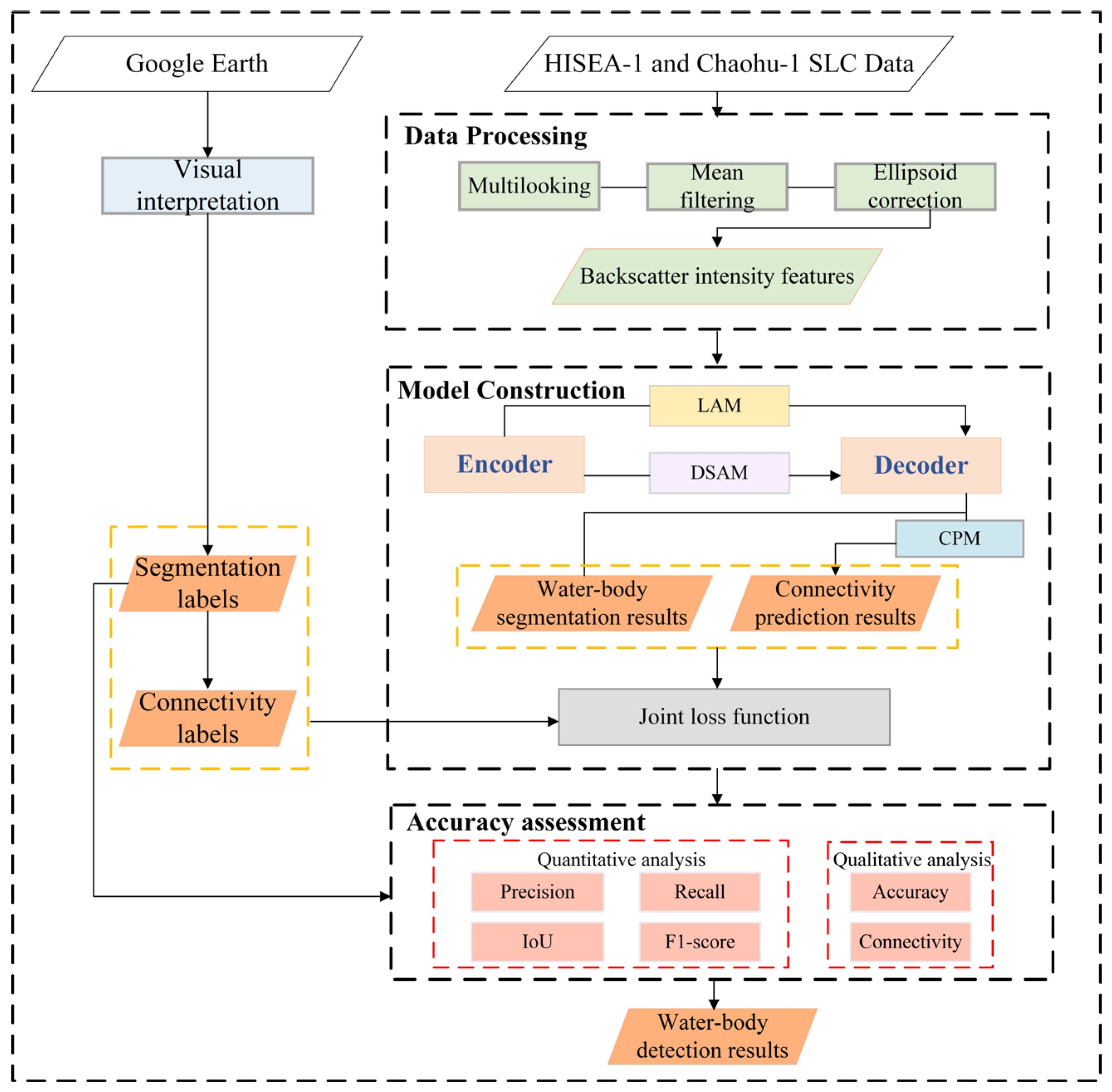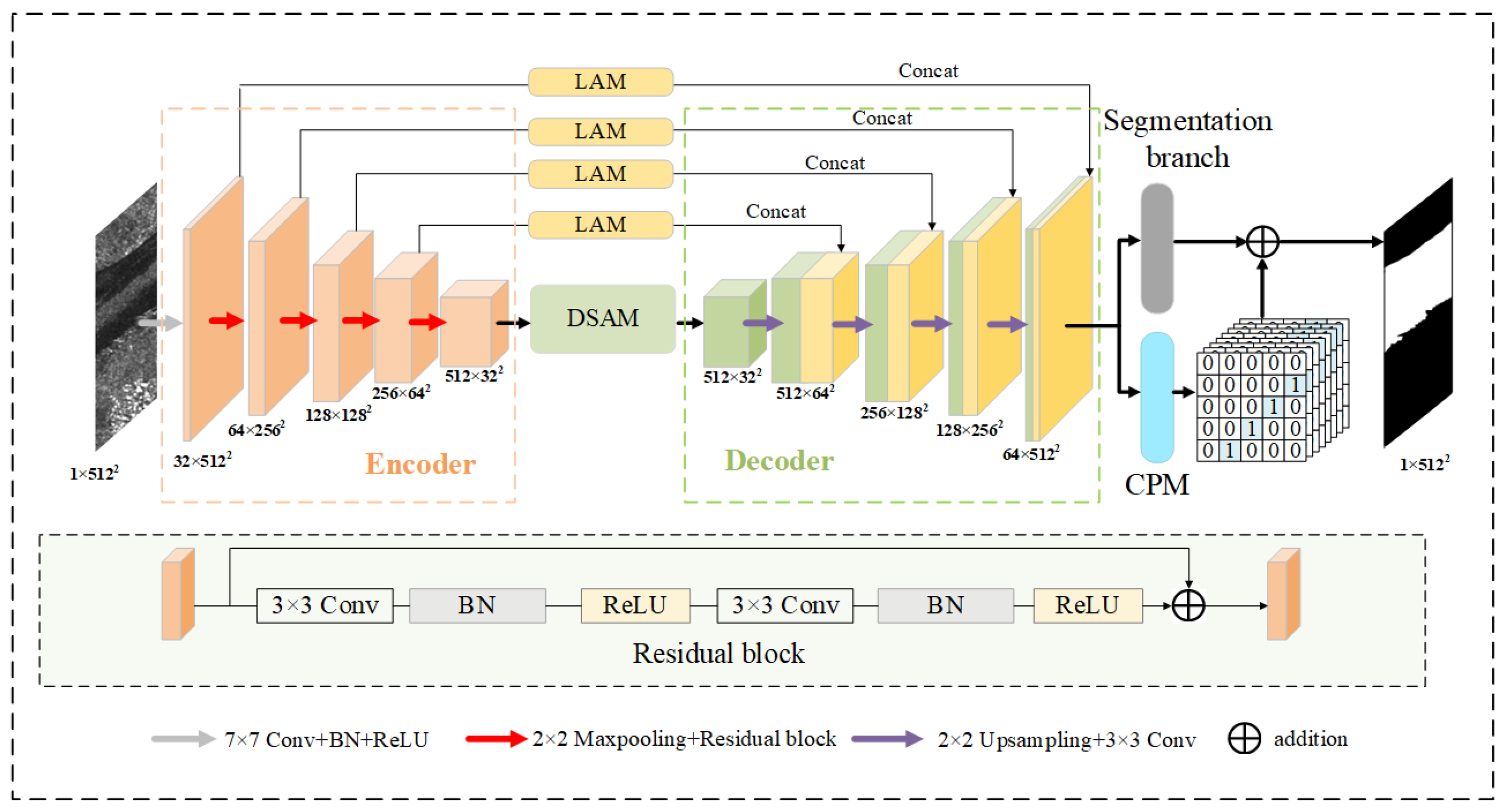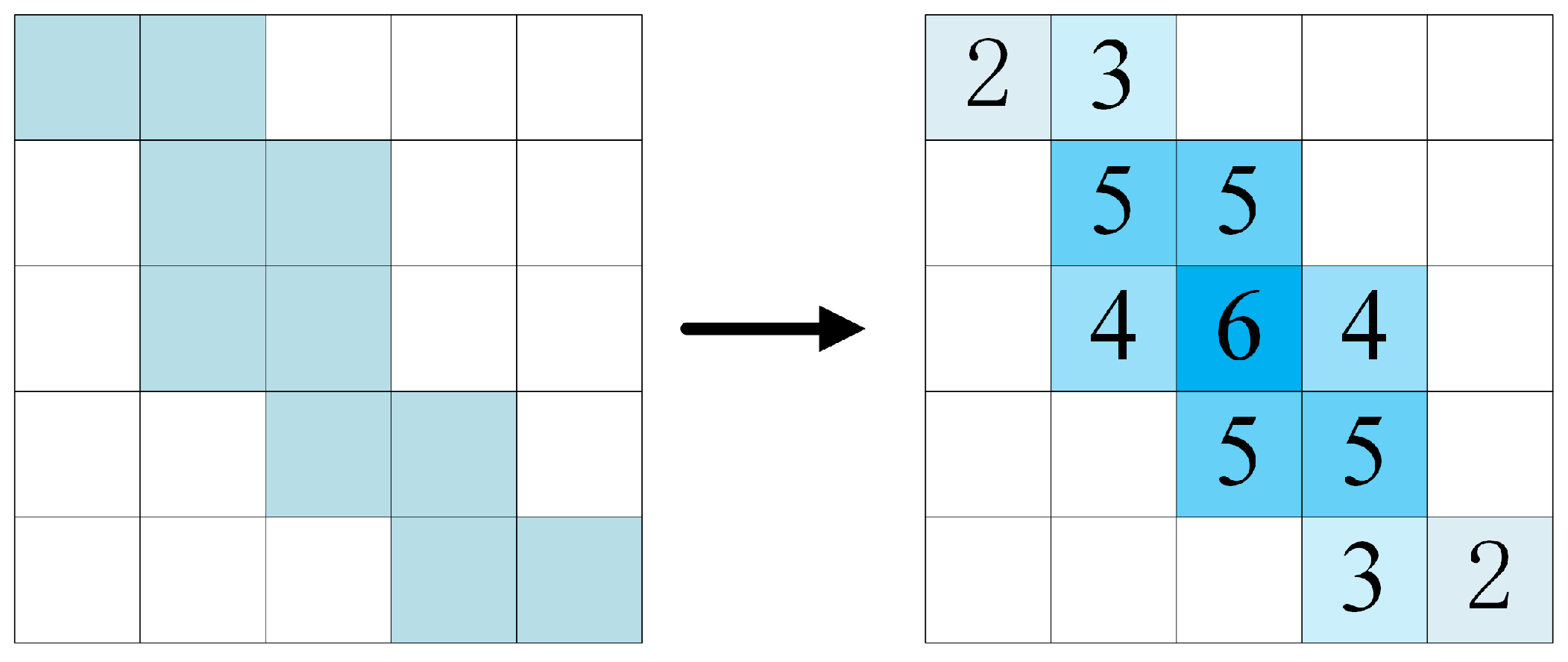Water-Body Detection from SAR Images Using Connectivity Refinement Network
Abstract
1. Introduction
- A Dual Self-Attention Module (DSAM) to integrate global contextual features, reducing ambiguity from large-scale low-backscatter zones.
- A Local Attention Module (LAM) incorporated into skip connections to refine fine-grained spatial patterns and enhance robustness to localized speckle noise.
- A novel Connectivity Prediction Module (CPM) with a joint loss function that explicitly models water-body topology, forcing the network to produce contiguous, physically realistic water networks rather than fragmented segments.
2. Materials and Methods
2.1. Study Area and Data
2.1.1. Study Area
2.1.2. SAR Data and Pre-Processing
2.1.3. Dataset Creation
2.2. Methodology
2.2.1. ConRNet Construction
2.2.2. Dual Self-Attention Module
2.2.3. Local Attention Module
2.2.4. Connectivity Prediction Module
2.2.5. Joint Loss Function
3. Results
3.1. Implementation Details
3.2. Evaluation Metrics
3.3. Comparative Evaluation of ConRNet and Other Methods
3.4. Evaluation of Ablation Experiments
4. Discussion
4.1. Model Application
4.2. Post-Processing and Error Analysis
4.3. Model Limitations and Future Directions
5. Conclusions
Author Contributions
Funding
Data Availability Statement
Acknowledgments
Conflicts of Interest
References
- Cheng, T.; Liu, R.; Zhou, X. Water Information Extraction Method in Geographic National Conditions Investigation Based High Resolution Remote Sensing Images. Bull. Surv. Mapp. 2014, 4, 86–89. [Google Scholar]
- Huang, W.; DeVries, B.; Huang, C.; Lang, M.W.; Jones, J.W.; Creed, I.F.; Carroll, M.L. Automated extraction of surface water extent from Sentinel-1 data. Remote Sens. 2018, 10, 797. [Google Scholar] [CrossRef]
- Guo, Z.; Wu, L.; Huang, Y.; Guo, Z.; Zhao, J.; Li, N. Water-body segmentation for SAR images: Past, current, and future. Remote Sens. 2022, 14, 1752. [Google Scholar] [CrossRef]
- Liu, H.; Jezek, K.C. Automated Extraction of Coastline from Satellite Imagery by Integrating Canny Edge Detection and Locally Adaptive Thresholding Methods. Int. J. Remote Sens. 2004, 25, 937–958. [Google Scholar] [CrossRef]
- Tan, J.; Tang, Y.; Liu, B.; Zhao, G.; Mu, Y.; Sun, M.; Wang, B. A self-adaptive thresholding approach for automatic water extraction using sentinel-1 SAR imagery based on Otsu algorithm and distance block. Remote Sens. 2023, 15, 2690. [Google Scholar] [CrossRef]
- Silveira, M.; Heleno, S. Classification of Water Regions in SAR Images Using Level Sets and Non-Parametric Density Estimation. In Proceedings of the 16th IEEE International Conference on Image Processing (ICIP), Cairo, Egypt, 7–10 November 2009; pp. 1685–1688. [Google Scholar]
- Li, N.; Wang, R.; Deng, Y.; Chen, J.; Liu, Y.; Du, K.; Lu, P.; Zhang, Z.; Zhao, F. Waterline Mapping and Change Detection of Tangjiashan Dammed Lake After Wenchuan Earthquake from Multitemporal High-Resolution Airborne SAR Imagery. IEEE J. Sel. Top. Appl. Earth Obs. Remote Sens. 2014, 7, 3200–3209. [Google Scholar] [CrossRef]
- Possa, E.M.; Maillard, P. Precise delineation of small water bodies from Sentinel-1 data using support vector machine classification. Can. J. Remote Sens. 2018, 44, 179–190. [Google Scholar] [CrossRef]
- Zhang, X.; Xu, J.; Chen, Y.; Xu, K.; Wang, D. Coastal wetland classification with GF-3 polarization SAR imagery by using object-oriented random forest algorithm. Sensors 2021, 21, 3395. [Google Scholar] [CrossRef]
- Obida, C.B.; Blackburn, G.A.; Whyatt, J.D.; Semple, K.T. River Network Delineation from Sentinel-1 SAR Data. Int. J. Appl. Earth Obs. Geoinf. 2019, 83, 101910. [Google Scholar] [CrossRef]
- Xu, P.; Gao, Z.; Wu, L.; Guo, Z.; Li, N.; Geng, Z.; Huang, Y. Water-Body Detection from Synthetic Aperture Radar Images Using Dual-Branch Fusion Network. J. Appl. Remote Sens. 2025, 19, 021008. [Google Scholar] [CrossRef]
- Zhan, W.; Chen, Y.; Liu, Q.; Li, J.; Sacchi, M.D.; Zhuang, M.; Liu, Q.H. Simultaneous prediction of petrophysical properties and formation layered thickness from acoustic logging data using a modular cascading residual neural network (MCARNN) with physical constraints. J. Appl. Geophys. 2024, 224, 105362. [Google Scholar] [CrossRef]
- Liu, D.; Wang, Q.; You, N.; Sacchi, M.D.; Chen, W. Filling the Gap: Enhancing Borehole Imaging with Tensor Neural Network. Geophysics 2024, 90, D71–D83. [Google Scholar] [CrossRef]
- Li, N.; Guo, Z.; Zhao, J.; Wu, L.; Guo, Z. Characterizing ancient channel of the Yellow River from spaceborne SAR: Case study of Chinese Gaofen-3 satellite. IEEE Geosci. Remote Sens. Lett. 2022, 19, 1502805. [Google Scholar] [CrossRef]
- Chen, L.; Zhang, P.; Xing, J.; Li, Z.; Xing, X.; Yuan, Z. A multi-scale deep neural network for water detection from SAR images in the mountainous areas. Remote Sens. 2020, 12, 3205. [Google Scholar] [CrossRef]
- Zhang, J.; Xing, M.; Sun, G.-C.; Chen, J.; Li, M.; Hu, Y.; Bao, Z. Water body detection in high-resolution SAR images with cascaded fully-convolutional network and variable focal loss. IEEE Trans. Geosci. Remote Sens. 2020, 59, 316–332. [Google Scholar] [CrossRef]
- Ren, Y.; Li, X.; Yang, X.; Xu, H. Development of a dual-attention U-Net model for sea ice and open water classification on SAR images. IEEE Geosci. Remote Sens. Lett. 2021, 19, 4010205. [Google Scholar] [CrossRef]
- Han, B.; Xing, G.; Lu, X.; Basu, A. AFUNet with active contour loss for water body detection in SAR imagery. IEEE J. Sel. Top. Appl. Earth Obs. Remote Sens. 2024, 17, 17540–17554. [Google Scholar] [CrossRef]
- Huang, B.; Li, P.; Lu, H.; Yin, J.; Li, Z.; Wang, H. WaterDetectionNet: A new deep learning method for flood mapping with SAR image convolutional neural network. IEEE J. Sel. Top. Appl. Earth Obs. Remote Sens. 2024, 17, 14471–14485. [Google Scholar] [CrossRef]
- Wang, J.; Jia, D.; Xue, J.; Wu, Z.; Song, W. Automatic water body extraction from SAR images based on MADF-Net. Remote Sens. 2024, 16, 3419. [Google Scholar] [CrossRef]
- Zortea, M.; Muszynski, M.; Fraccaro, P.; Weiss, J. Flood Mapping Using Sentinel-1 Images and Light-Weight U-Nets Trained on Synthesized Events. IEEE Geosci. Remote Sens. Lett. 2023, 20, 1502905. [Google Scholar] [CrossRef]
- Yuan, Q.; Wu, L.; Huang, Y.; Guo, Z.; Li, N. Water-body detection from spaceborne SAR images with DBO-CNN. IEEE Geosci. Remote Sens. Lett. 2023, 20, 4013405. [Google Scholar] [CrossRef]
- Liu, Y.; Shao, Z.; Teng, Y.; Hoffmann, N. NAM: Normalization-based attention module. arXiv 2021, arXiv:2111.12419. [Google Scholar] [CrossRef]
- Long, J.; Shelhamer, E.; Darrell, T. Fully convolutional networks for semantic segmentation. In Proceedings of the IEEE conference on computer vision and pattern recognition, Boston, MA, USA, 7–12 June 2015; pp. 3431–3440. [Google Scholar]
- Ronneberger, O.; Fischer, P.; Brox, T. U-net: Convolutional networks for biomedical image segmentation. In Medical Image Computing and Computer-Assisted Intervention–MICCAI 2015: 18th International Conference; Springer: Munich, Germany, 2015. [Google Scholar]
- Chen, L.C.; Zhu, Y.; Papandreou, G.; Schroff, F.; Adam, H. Encoder-decoder with atrous separable convolution for semantic image segmentation. In Proceedings of the European Conference on Computer Vision (ECCV); Springer: Berlin/Heidelberg, Germany, 2018; pp. 801–818. [Google Scholar]
- Sun, K.; Xiao, B.; Liu, D.; Wang, J. Deep high-resolution representation learning for human pose estimation. In Proceedings of the IEEE/CVF Conference on Computer Vision and Pattern Recognition, Long Beach, CA, USA, 15–20 June 2019; pp. 5693–5703. [Google Scholar]
- Zhu, L.; Zhou, Z.; Zhang, Y.; Sun, Y.; Liu, X.; Kan, X.; Cao, H.; Li, Z. Water body extraction based on multi-scale attention from synthetic aperture radar images. J. Appl. Remote Sens. 2024, 18, 036510. [Google Scholar] [CrossRef]











| Parameter | HISEA-1 | Chaohu-1 |
|---|---|---|
| Product format | Level-1 SLC | Level-1 SLC |
| Beam mode | Strip Map | Strip Map |
| Band | C | C |
| Spatial resolution | 3 m | 3 m |
| Acquisition data | 10 February 2022 | 28 September 2022 |
| Configuration | Version |
|---|---|
| GPU | NVIDIA RTX A5000 |
| RAM | 24 GB |
| Frame | PyTorch 2.0.1 |
| Language | Python 3.8.18 |
| Method | Precision (%) | Recall (%) | IoU (%) | F1-Score (%) | CCE | LC-IoU (%) | Params (M) | FLOPs (G) |
|---|---|---|---|---|---|---|---|---|
| FCN | 90.16 | 89.27 | 81.90 | 89.75 | 15 | 79.43 | 134.17 | 161.54 |
| U-Net | 91.22 | 90.53 | 83.33 | 90.87 | 12 | 81.05 | 31.03 | 219.50 |
| DeepLabv3+ | 91.89 | 90.20 | 83.69 | 91.04 | 10 | 83.14 | 16.68 | 11.82 |
| HRNet | 92.14 | 91.68 | 85.06 | 91.91 | 8 | 84.47 | 66.42 | 16.15 |
| MAG-Net | 92.93 | 92.05 | 87.26 | 92.62 | 6 | 86.52 | 16.44 | 79.25 |
| ConRNet | 94.42 | 93.28 | 88.59 | 93.87 | 4 | 88.36 | 22.20 | 246.53 |
| Case | DSAM | LAM | CPM | Precision (%) | Recall (%) | IoU (%) | F1-Score (%) | CCE | LC-IoU (%) |
|---|---|---|---|---|---|---|---|---|---|
| 1 | Removed | Removed | Removed | 91.38 | 91.09 | 83.90 | 91.23 | 10 | 81.24 |
| 2 | Removed | Present | Present | 92.81 | 91.49 | 86.83 | 92.15 | 7 | 84.72 |
| 3 | Present | Removed | Present | 93.04 | 92.61 | 86.64 | 92.82 | 6 | 85.03 |
| 4 | Present | Present | Removed | 92.68 | 92.14 | 85.93 | 92.41 | 8 | 83.97 |
| ConRNet | Present | Present | Present | 94.42 | 93.28 | 88.59 | 93.87 | 4 | 88.36 |
| Evaluation Aspect | Metric | Without Post-Processing | With Post-Processing |
|---|---|---|---|
| Morphological refinement effect | IoU (%) | 87.99 | 88.59 |
| LC-IoU (%) | 87.56 | 88.36 |
| Region Type | IoU (%) | Precision (%) |
|---|---|---|
| Normal land surface | 88.59 | 94.42 |
| Low-backscatter land | 86.28 | 91.79 |
Disclaimer/Publisher’s Note: The statements, opinions and data contained in all publications are solely those of the individual author(s) and contributor(s) and not of MDPI and/or the editor(s). MDPI and/or the editor(s) disclaim responsibility for any injury to people or property resulting from any ideas, methods, instructions or products referred to in the content. |
© 2025 by the authors. Licensee MDPI, Basel, Switzerland. This article is an open access article distributed under the terms and conditions of the Creative Commons Attribution (CC BY) license (https://creativecommons.org/licenses/by/4.0/).
Share and Cite
Gao, Z.; Sun, J.; Xu, P.; Wu, L.; Huang, Y.; Li, N.; Zhu, Z.; Pu, Q. Water-Body Detection from SAR Images Using Connectivity Refinement Network. Earth 2025, 6, 148. https://doi.org/10.3390/earth6040148
Gao Z, Sun J, Xu P, Wu L, Huang Y, Li N, Zhu Z, Pu Q. Water-Body Detection from SAR Images Using Connectivity Refinement Network. Earth. 2025; 6(4):148. https://doi.org/10.3390/earth6040148
Chicago/Turabian StyleGao, Zile, Jinkai Sun, Puyan Xu, Lin Wu, Yabo Huang, Ning Li, Zhuang Zhu, and Qianchao Pu. 2025. "Water-Body Detection from SAR Images Using Connectivity Refinement Network" Earth 6, no. 4: 148. https://doi.org/10.3390/earth6040148
APA StyleGao, Z., Sun, J., Xu, P., Wu, L., Huang, Y., Li, N., Zhu, Z., & Pu, Q. (2025). Water-Body Detection from SAR Images Using Connectivity Refinement Network. Earth, 6(4), 148. https://doi.org/10.3390/earth6040148






